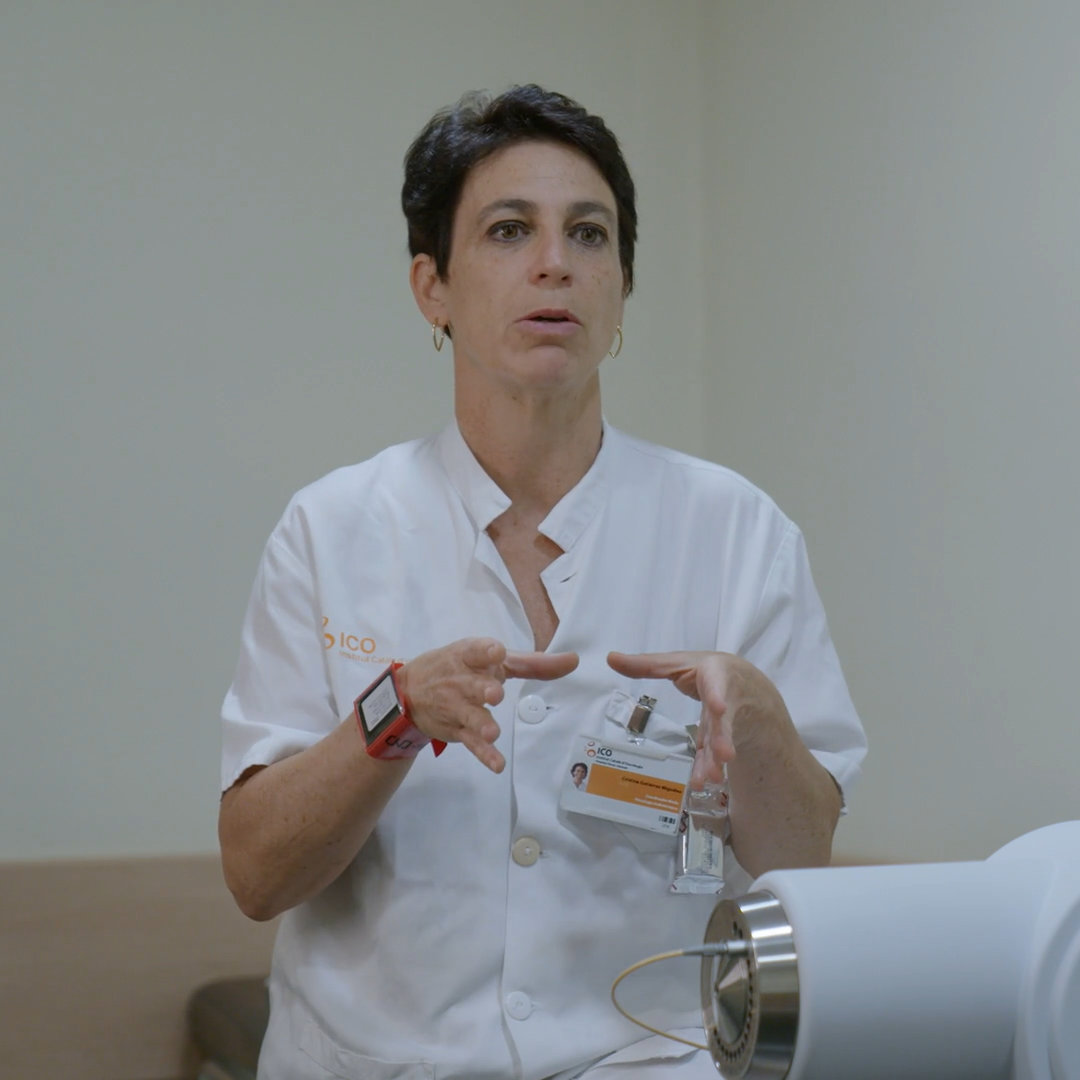
Understanding Brachytherapy
Healthcare Perspective
Dr Gutierrez
Dr. Cristina Gutiérrez is the clinical head and coordinator of the Brachytherapy unit at Hospital Duran i Reynals in Barcelona. In this video, Dr. Gutiérrez explains how she teaches medical students about brachytherapy and how it is different from external radiotherapy. She discusses the challenges of facilitating the procedure for the physician but why it remains a safe and effective treatment option for many patients with cancer.

What is Brachytherapy?
To help patients and their families understand more about brachytherapy, Dr. Cristina Gutiérrez recorded this video in which she explains what the treatment is and how it benefits many patients.
Brachytherapy, also called internal radiotherapy or internal radiation therapy, places radioactive material directly inside the patient - in or near the tumor - to kill cancer cells and shrink the tumor. Brachytherapy is a local treatment and treats only a specific part of your body. There are two types of brachytherapy, temporary where the radioactive seeds are removed once the internal radiation therapy is complete or permanent brachytherapy where the radioactive material remains in the body cavity for low dose rate brachytherapy.
Permanent Brachytherapy vs Temporary Brachytherapy
Permanent seed brachytherapy, also known as low dose-rate (LDR) brachytherapy, is a type of radiotherapy where the radioactive seeds are put where the tumor is located. This radiation therapy reduces the amount of appointments needed, the side effects and allows the healthy tissue to recover.
Temporary brachytherapy is a radiation therapy cancer treatment where the radioactive implants are removed after the treatment has ended. Implants, such as hollow needles, catheters (hollow tubes), or balloons filled with fluid, are inserted into or near the cancer for a period of time, then removed. This method may use high dose rate brachytherapy or a low radiation dose depending on your needs.

The Difference Between Brachytherapy and External Radiotherapy
When Dr. Gutiérrez teaches at the faculty of medicine, she always emphasizes the difference between brachytherapy and external radiotherapy.
Brachytherapy allows your healthcare team to administer higher doses of radiation therapy targeted directly to the tumor from inside the body, while keeping low doses to the surrounding tissue. Brachytherapy allows targeting a smaller area than external radiation therapy, which directs high-energy x-rays from outside the body.
The main benefit of brachytherapy is the ability to destroy cancerous cells in a more efficient way while minimizing the side effects for the patient. While internal radiation therapy can cause side effects such as urgency with toileting, and tenderness in the area, they are less likely to impact quality of life, unlike external radiation therapy. Side effects for brachytherapy are typically mild and lasts 1 or 2 weeks.
External radiotherapy is the traditional method of using a linear acceleration (LINAC) machine to expose the part of the body affected by cancer to radiation. The LINAC is a machine which is designed to administer radiation therapy for cancer treatments. This is less accurate and can impact the cells and tissue around the tumor which creates further side effects. External radiation therapy can cause longer side effects such as nausea, fatigue, memory loss and can increase the risks of being diagnosed with secondary cancer.
Brachytherapy Technique
After reviewing the benefits of brachytherapy, Dr. Gutiérrez's students often ask her why the therapy is not systematically offered to all patients in need of radiation therapy.
The goal of the brachytherapy treatment is to deliver radiation sources directly at the tumor site, which means the most challenging part is the actual access to the targeted area. The technique involves inserting radioactive materials through the skin or into the body cavity, using catheters or applicators.
Brachytherapy is a high-precision treatment and during the procedure, the accuracy of needle placement is critical to the cancer treatment. If the size and location of the tumor is not precisely defined pre-operatively, or the applicators are not accurately positioned, the radiation dose may not provide sufficient radiation to parts of the tumor. In brachytherapy, access to the tumor site itself remains the biggest challenge and sometimes it won't be possible. It will depend on the type of cancer and the size, shape, and location of the tumor.
There are specific cancer types that are ideal for internal radiation therapy, including; prostate cancer, breast cancer, skin cancer, and cervical cancer.
Why Choose Brachytherapy Over Other Cancer Treatments?
Brachytherapy can be a challenging technique for the radiation oncologist, but it presents many benefits and remains a standard of care for treating cancer.
- One of the main benefits of brachytherapy is its capability to deliver a higher dose of radiation in a limited area than might be possible with conventional external radiation treatments. This can be more effective at destroying the cancer cells and shrinking the tumor.
- Since radiation decays very quickly, the dose received by healthy surrounding organs is very low. This means that the acute and long-term toxicity will be much less, which means the likelihood of side effects decreases. This is what happens in the case of breast cancer for example, where a much lower dose of radiation reaches the heart and lungs.
Compared to external radiation therapy, brachytherapy requires fewer treatment sessions or "fractions" but delivers a higher dose of radiation per fraction. This means that the overall treatment time can be reduced, which can be beneficial for patients.
In radiation therapy, a "fraction" refers to a single dose of radiation that is delivered during a treatment session. Radiation treatments are usually given in multiple fractions over several weeks to allow healthy tissues to recover between doses and to reduce the risk of side effects. The specific number of fractions and the dose of radiation delivered per fraction will depend on the type of cancer being treated and the patient's individual needs.
Brachytherapy has a long history with a track record as a safe and effective procedure. For certain types of cancers and when the tumor is accessible, patients can benefit from this therapy that enables the oncologist to deliver a high dose of radiation to a very localized area while preserving the healthy nearby organs.
About Dr. Cristina Gutiérrez
Dr. Cristina Gutiérrez is a Professor of Oncology and Radiology at the University of Barcelona. She graduated from the Autonomous University of Barcelona in 1989 with a degree in Medicine and Surgery. She earned her Ph.D. from the same university in 2002. Her areas of interest are brachytherapy and breast cancer, especially partial breast irradiation with brachytherapy, as well as uveal melanoma. Dr. Cristina Gutiérrez leads the Brachytherapy Unit at the Catalan Institute of Oncology - L'Hospitalet de Llobregat (Barcelona).
